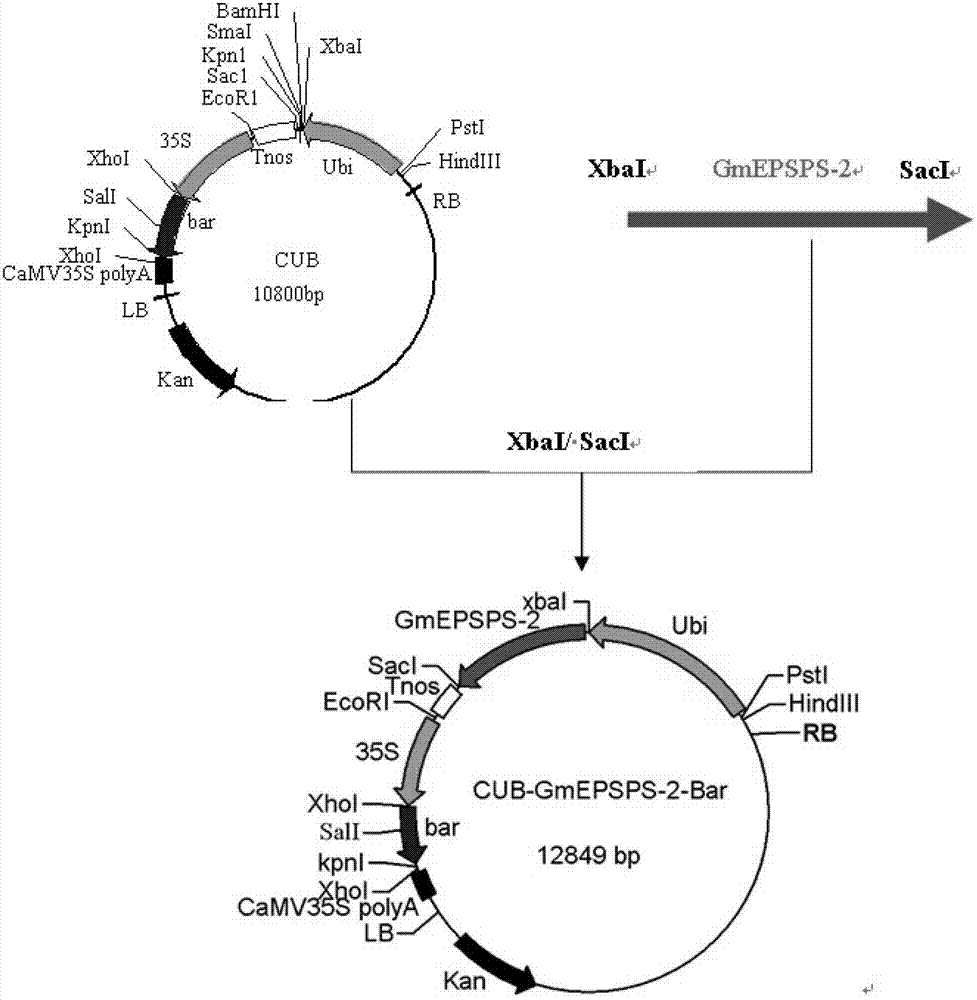Anti-glyphosate EPSP (enolpyruvyl shikimate phosphate) synthase GmEPSPS-2 as well as encoding gene and application thereof
A coding and amino acid technology, applied in application, genetic engineering, plant gene improvement, etc., can solve problems such as low expression efficiency
- Summary
- Abstract
- Description
- Claims
- Application Information
AI Technical Summary
Problems solved by technology
Method used
Image
Examples
Embodiment 1
[0073] Embodiment 1, the modification synthesis of GmEPSPS-2 gene
[0074] According to the mutant gene of 5-enolpyruvate-3-phosphate synthase (EPSPS) derived from Pseudomonas fluorescens, the original gene ORF sequence 5 was deleted Two base sequences of 147 bp at the 'end and 531 bp at the 3' end, leaving only a base sequence of 654 bp in the middle core domain sequence, which is spliced with a base sequence of 636 bp from the EPSPS gene of Agrobacterium tumefaciens CP4; In the case of ensuring that the amino acid sequence of the transformed EPSP synthetase protein remains unchanged, base substitutions are performed with plant-favored codons to initially obtain a modified DNA sequence; the presence of DNA sequences that cause unstable transcription in plants is eliminated Rich in AT sequences and commonly used restriction enzyme sites (BamH I, EcoR I, Hind III, Nco I, Xho I, Xba I, etc.), and then corrected and eliminated by replacing codons; and added at the 5' end Maize...
Embodiment 2
[0077] Embodiment 2, the construction of anti-glyphosate fusion gene plant expression vector
[0078] Artificially synthesize the GmEPSPS-2 gene shown in Sequence 2 in the sequence listing, double-enzyme-cut the GmEPSPS-2 gene with Xba I and Sac I respectively, and simultaneously double-enzyme-cut the plant expression vectors CPB and CUB with Xba I and Sac I respectively, The digested GmEPSPS-2 fragment and the backbone fragments of the CPB vector and the CUB vector were recovered with a gel extraction and purification kit. The GmEPSPS-2 fragment was ligated with the backbone fragments of the CPB vector and the CUB vector respectively to obtain the target plasmid. Transfer the target plasmid into Escherichia coli, screen for resistance, pick positive single clones, carry out liquid culture of positive single clones, extract positive clone plasmids for Xba I and Sac I double enzyme digestion identification, and initially determine the correctness after enzyme digestion identifi...
Embodiment 3
[0081] Embodiment 3, glyphosate herbicide tolerance test
[0082] Preparation of M9 medium:
[0083] (1) First prepare 1M MgSO 4 : Weigh MgSO 4 ·7H 2 Add 2.46g of O to 10mL of double distilled water to dissolve, autoclave for later use;
[0084] (2) Prepare 1M CaCl 2 : CaCl 2 ·6H 2 O 2.191g was dissolved in 10mL of double-distilled water, and autoclaved for later use;
[0085] (3) Prepare 5×M9 salt solution again:
[0086] Na 2 PO 4 ·7H 2 O 12.8g
[0087] K H 2 PO 4 3.0g
[0088] NaCl 0.5g
[0089] NH 4 Cl 1.0g
[0090] Add 200ml of double distilled water to dissolve, and sterilize at 121°C for 15 minutes.
[0091] Remarks: The above three samples are prepared separately, bottled separately, and can be sent to high pressure together.
[0092] (4) Prepare 20% glucose solution: 4g glucose is dissolved in 20ml of double distilled water, and sterilized by filtering through a 0.22 micron filter;
[0093] (5) Preparation of M9 medium by aseptic operation
[009...
PUM
 Login to View More
Login to View More Abstract
Description
Claims
Application Information
 Login to View More
Login to View More - R&D
- Intellectual Property
- Life Sciences
- Materials
- Tech Scout
- Unparalleled Data Quality
- Higher Quality Content
- 60% Fewer Hallucinations
Browse by: Latest US Patents, China's latest patents, Technical Efficacy Thesaurus, Application Domain, Technology Topic, Popular Technical Reports.
© 2025 PatSnap. All rights reserved.Legal|Privacy policy|Modern Slavery Act Transparency Statement|Sitemap|About US| Contact US: help@patsnap.com



